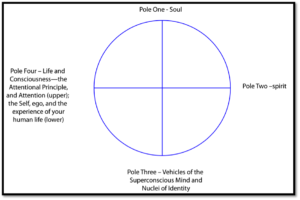By George A. Boyd © 2021
Q: Can you explain the role of concentration in spiritual life?
A: Concentration means that you shrink the focus of your attention and hold it on an object. There are several levels at which you can apply concentration:
- Schema – this is a category in which you access stored knowledge about a particular topic. You use this in study and academic education. You might, for example, focus on the schema where you have learned rules for grammar. You would learn the new material about this subject and remember it in the frame of the schema, associating it to your current knowledge.
- Matrix of experience – You access this level when you ask your deeper mind questions and listen for the answers. You might ask for a particular incident (process meditation), a specific fact (mnemonic recall), how you feel about something (emotional inquiry), what something means (cognitive inquiry), what your options and choices are (personal inquiry), or ask for information about spiritual topics (metaphysical inquiry). You concentrate in this band when you are doing personal process, inner dialog, or psychotherapy.
- Reflection – You access this level when you think deeply about something and you want to solve a problem. This accesses your intellect, whereby you apply your intelligence to explore ideas and to solve problems. Those who are writers, scientists, and philosophers tap into this level of concentration.
- Archetypes and arrays – You access this level when you interface with elements in your Superconscious mind. You might encounter an archetype and reflect on the meaning of the form you see. You might explore the meaning of a myth or wisdom story. You might contemplate the meaning of a scripture. You might associate symbols in an array to do an intuitive reading. Theologians, metaphysical counselors, psychic readers, and transpersonal psychologists interface with this level.
- Nucleus of identity – You access this level when you focus your attention on one of the integration centers of your Superconscious mind. These centers include, for example, the Star Seed on the Psychic Realm, the Moon Soul in the First Planetary Initiation, Cosmic Consciousness in the First Cosmic Initiation, or the Supracosmic Seed Atom on a Supracosmic Path. Those following a religious or spiritual group focus at this level.
- Attentional principle – Focusing your attention at this level awakens your intentional consciousness. Once you can function at this level readily, you can perform inner work on your personality and in your Superconscious mind.
- Individual spirit – Focusing your attention at this level awakens the love and devotion of your spirit. Once you can readily focus your attention at this level, you can participate in opening the channels of the Nada through which your spirit returns to its origin.
- Ensouling entity – Focusing your attention at this level awakens the Soul. This brings about the experience of Samadhi and Gnosis. This conveys the Realization of the Inner Divinity within the Soul, and aligns you with the Soul’s Path of spiritual evolution.
Direct spiritual experience is contingent upon your ability to concentrate upon the spiritual essences at levels five through eight. We teach you how to tap levels 6, 7, and 8 in our intermediate meditation courses—the in-person Mudrashram® Master Course in Meditation and the by-mail and online Accelerated Meditation Program. We teach contemplation of nuclei of identity, level 5, in the Mudrashram® Advanced Course in Meditation.
Developing facility with levels one and two is important for successful learning and adult functioning. Those who are thinkers and who are able to access the creative and intuitive channels of their mind learn to tap into levels three and four.
We encourage you to become familiar with each of these levels of concentration, and learn how to use these attentional foci skillfully and efficiently to bring success in your life and to awaken to your full spiritual potentials.







